The Intel Broadwell Desktop Review: Core i7-5775C and Core i5-5675C Tested (Part 1)
by Ian Cutress on June 2, 2015 7:45 AM ESTProfessional Performance: Windows
Agisoft Photoscan – 2D to 3D Image Manipulation: link
Agisoft Photoscan creates 3D models from 2D images, a process which is very computationally expensive. The algorithm is split into four distinct phases, and different phases of the model reconstruction require either fast memory, fast IPC, more cores, or even OpenCL compute devices to hand. Agisoft supplied us with a special version of the software to script the process, where we take 50 images of a stately home and convert it into a medium quality model. This benchmark typically takes around 15-20 minutes on a high end PC on the CPU alone, with GPUs reducing the time.
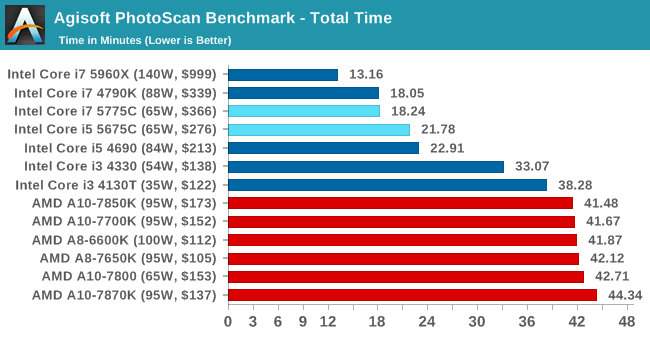
The presence of Crystal Well had a small effect on Photoscan, occurring mostly in the second phase of the calculation which is the one that also has an option to enable the GPU, indicating that memory bandwidth is an potential limitation in that segment.
Cinebench R15
Cinebench is a benchmark based around Cinema 4D, and is fairly well known among enthusiasts for stressing the CPU for a provided workload. Results are given as a score, where higher is better.
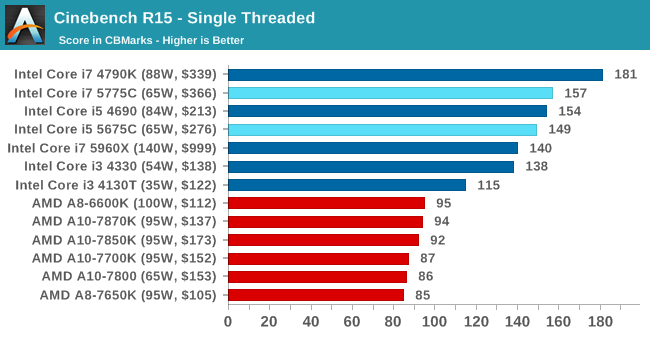
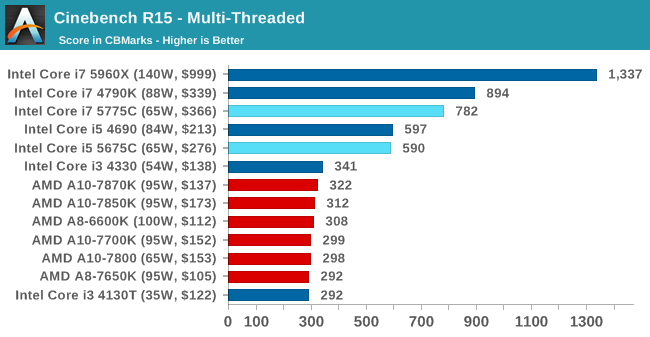
Cinebench is a historically CPU-limited benchmark, and the results show this again here. The fact that the 3.6GHz Broadwell-based i5-5675C performs so closely to the 3.9GHz Haswell-based i5-4690 is a promising sign here, as it means that despite being a mere "tick" in Intel's development efforts, there are tangible IPC increases on the desktop from Broadwell.
HandBrake v0.9.9: link
For HandBrake, we take two videos (a 2h20 640x266 DVD rip and a 10min double UHD 3840x4320 animation short) and convert them to x264 format in an MP4 container. Results are given in terms of the frames per second processed, and HandBrake uses as many threads as possible.
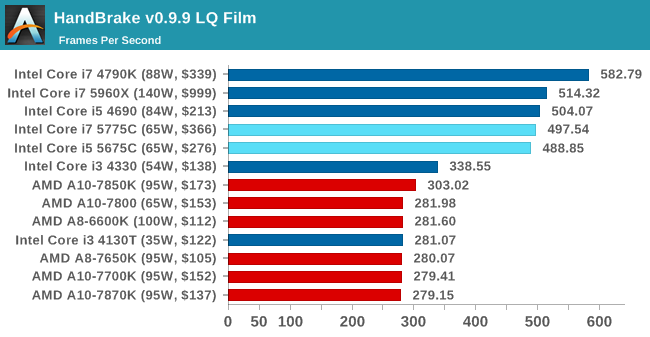

While no obvious improvement was seen in the low quality conversion, the double UHD conversion put the i7 above what was otherwise expected.
Hybrid x265
Hybrid is a new benchmark, where we take a 4K 1500 frame video and convert it into an x265 format without audio. Results are given in frames per second.
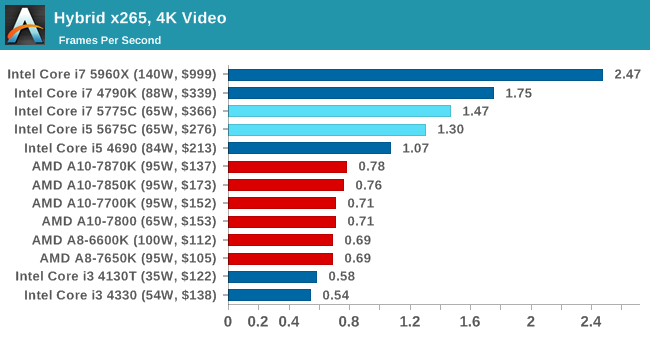
Unlike the Handbrake H.264 tests, the Hybrid x265 tests show a clear uptick in performance on the Broadwell processors. It is not fast enough to catch the i7-4790K and its 4.4GHz turbo clockspeed, but we see the i5-5675C shoot well past the i5-4690 despite the clockspeed deficit. Whether this is due to Broadwell architecture enhancements, Crystal Well acting as an L4 cache, or a combination of the two is difficult to determine, but the end result is substantial.










196 Comments
View All Comments
Gothmoth - Tuesday, June 2, 2015 - link
well we can dream.i could use more cores.
i use heavy multithreaded applications and do heavy multitasking.
yet i have to live with 10% better performance per cpu generation. :(
haswell-e is the only choice when i want to upgrade.
but it runs hot and i have no use at all for internal graphics.
so why not making another CPU tailored for people like us?
i mean intel makes enough different CPUs anyway.
Gothmoth - Tuesday, June 2, 2015 - link
ah that reads wrong... i know that haswell-e has no internal graphics.what i meant was... haswell-e runs hot and for the other cpus like broadwell i have no use of the internall GPU.
DCide - Tuesday, June 2, 2015 - link
All this wishful thinking on your part tells me you probably don't have a very strong, actual NEED. Because if you did, you'd be ecstatic about the 5820K or 5960X. They run at 4GHz all day long with standard air cooling and no knowledge of overclocking (I just use ASRock's SLOWEST default overclock settings in the BIOS setup).It's almost humorous when I read these benchmarks, because they so understate the true, completely stable performance of the 5960X without doing any extra work setting it up. It's nearly twice as fast as the 4790K in practice (in fact it *is* about twice as fast when you consider how easily and quickly the 4790K throttles in a typical configuration).
I realize there are situations where generating more heat in the room matters. But if your multitasking were genuinely heavy enough to warrant the upgrade to 6 or 8 cores, you'd be foolish not to take advantage of the great solution that's available right now.
MrSpadge - Tuesday, June 2, 2015 - link
Double the cores means double the power consuption. There's no way around this, except making each core run slower.. which diminishes the benefit of having them. If Haswell-E runs too hot for you, no other chip Intel would reasonably want to produce right now would satisfy you.nikaldro - Tuesday, June 2, 2015 - link
But haswell-E is still on 22nm, not 14nm.nevcairiel - Tuesday, June 2, 2015 - link
Then wait for Broadwell-E.Azurael - Tuesday, June 2, 2015 - link
Why would you want to invest in 3 sticks of DDR4 RAM which will bring nearly no performance benefit and a massively overpriced motherboard for an extra couple of cores? It's not the cost of the Haswell-Es, or even their power consumption that bugs me - I suspect dual channel DDR3 is perfectly adequate for 6 cores alone given that it is apparently adequate for 4+GPU.Still, it makes my investment in a 2500K which has been running at 4.5GHz on stock voltage for the last 3 and a half years on the cheapest Z68 board I could buy sound rather good. I think I'd struggle to gain more than 20% in performance for the outlay of buying a new motherboard and CPU. I built a 4770K-based rig for a friend last year, it won't scrape past 4.2GHz. I'm sure IPC + HT + Faster RAM makes it faster than my rig, but certainly not in any noticeable fashion.
DCide - Tuesday, June 2, 2015 - link
Obviously it wouldn't matter to you. You didn't even bother to go with an i7.But for those to whom it does matter it's the biggest step up we've seen in a desktop CPU in a long time. The additional RAM and motherboard cost is trivial to those for whom the extra performance provides more than amusement.
Azurael - Tuesday, June 2, 2015 - link
You're correct - to me, it seems adequate for video editing and running Android builds... I'm sure in your 'elite' i7 world, things are far quicker. My issue is not with the fact that Intel offers higher spec or more expensive parts. Obviously, there would be no need for 18-core Xeons in this hypothetical world. My issue the fact that they artificially constrain the 'mid' range dual channel architecture to 4 cores and lump us with an IGP that's never going to get used taking up more die space than the extra couple of cores would just because they don't have any competition.Azurael - Tuesday, June 2, 2015 - link
And by the way, a ~84W TDP CPU is going to throttle when overclocked - especially when running AVX loads. If you haven't found the current limits in the BIOS, you probably deserve to believe your expensive 6-core running at only 4GHz is twice as fast as a properly set up 4790K :P